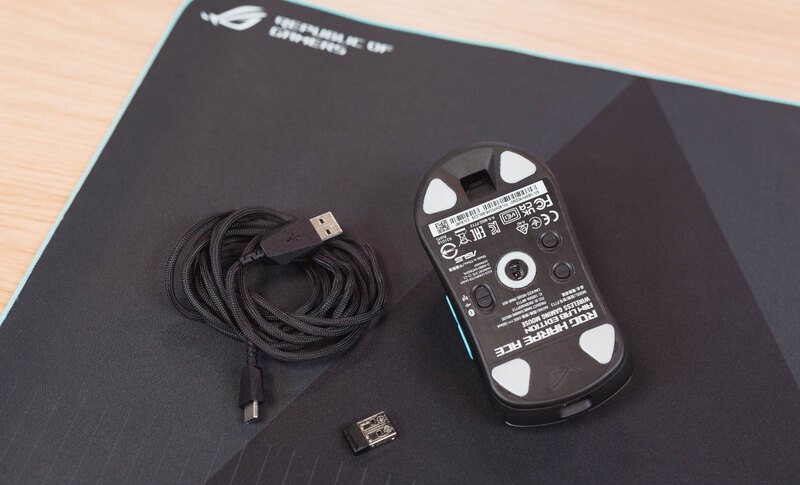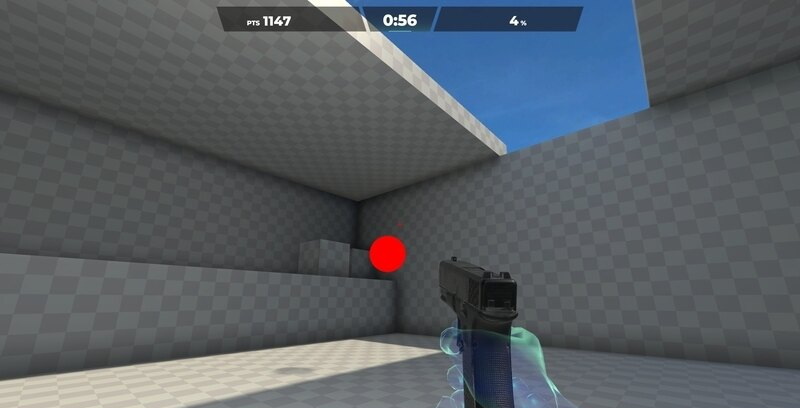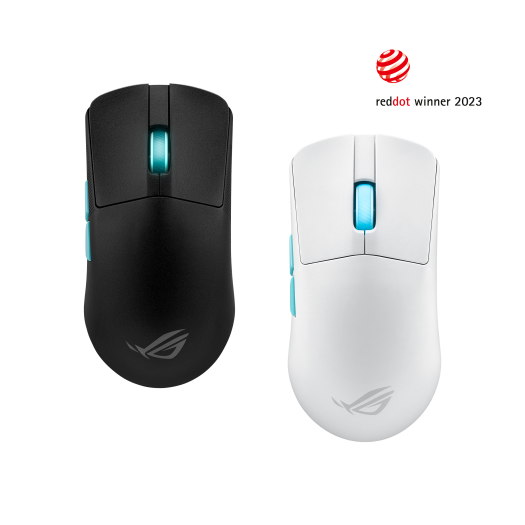Introduction: The bulky gaming mice era is slowly fading as ultralight models take the spotlight. Gamers now prioritize efficiency and performance over extravagant designs. The Asus ROG Harpe Ace Aim Lab Edition caters to competitive gamers seeking a swift and lightweight mouse capable of precise tracking in all scenarios. This mouse offers practicality with six buttons, RGB lighting, and both wired and wireless (2.4 GHz and Bluetooth) connectivity options.

Priced at €159, the Asus ROG Harpe Ace aims for the high end of the market, leveraging its featherweight build and a partnership with Aim Lab, which adds exclusive training game features.
Ergonomics:
Unlike Asus’ striking designs in the ROG (Republic of Gamers) range, the Harpe Ace adopts a more understated appearance, with gaming cues primarily visible through its RGB backlit wheel, logo, and color scheme. The left edge features the Aim Lab logo, which becomes visible under blue UV light – a nice touch for enthusiasts.
To achieve an impressive weight of 54g, lighter than even Razer’s Viper V2 Pro, Asus opted for a bio-sourced nylon material. While the textured plastic may not be visually appealing, the build quality is impeccable, albeit not as luxurious as its price suggests.
Underneath the mouse, you’ll find a switch to select the connection mode (2.4 GHz wireless, Bluetooth, or wired), a pairing button, and a shortcut button to adjust the sensitivity. The placement of the sensitivity adjustment button may not be ideal for in-game use. Still, it helps save weight on the mouse since sensitivity adjustments during gameplay are relatively rare. You can configure shortcuts, including sensitivity, dropout distance, and sampling rate, using the Armory Crate software suite. Additionally, a dedicated slot allows you to store the 2.4 GHz dongle securely.
Unlike some ultralight models, the Asus ROG Harpe Ace doesn’t compromise on backlighting. The wheel is the sole illuminated element. Beyond aesthetics, this indicates the battery status, ensuring you’re never caught without power during a gaming session. Using the in-house software suite, RGB lighting effects can be customized and synchronized with other Asus components.

With its classic shape, the mouse accommodates various grip styles, including claw, fingertip, and palm rest. It’s almost ambidextrous, missing only right-side buttons to cater to left- and right-handed users. The edges feature ribbed textures for improved grip, and Asus includes non-slip stickers for further customization. Additionally, purchasers receive an extra set of five Teflon pads to maintain smooth mouse movement on the pad.
Charging is done via USB-C, and Asus wisely leaves the port accessible, allowing you to use any compatible cable. However, using the provided ROG Paracord cable is recommended, known for its exceptional flexibility, which mimics the freedom of wireless play. Unfortunately, wireless charging is not an option, unlike some other models.
Precision:
Asus employs its in-house AimPoint sensor in the ROG Harpe Ace Aim Lab Edition, which is also featured in other Asus gaming mice like the ROG Keris AimPoint and Gladius III AimPoint. While the specifics of the AimPoint sensor remain undisclosed, it appears to be a modified PixArt 3395 sensor capable of an astonishing sensitivity of 36,000 DPI (or PPI for pixel per inch).
This sensor is one of PixArt’s most powerful offerings, withstanding accelerations of up to 50 g and delivering a tracking speed of 650 IPS (inches per second). For comparison, its main competitor, Logitech’s G Pro, falls behind in these aspects.

The Asus ROG Harpe Ace Aim Lab Edition positions itself ideally, offering competitive performance that can rival other gaming mice. However, Asus aims to distinguish itself through its partnership with Aim Lab, a training software designed to enhance players’ skills.
Aim Lab Software with Asus:
In conjunction with the mouse, Asus developed synergistic software in collaboration with Aim Lab Gaming. This partnership empowers gamers to calibrate their mouse according to their needs and abilities. When launching Aim Lab on their computer, owners of the Ace Harp can access the Settings Optimizer, a feature exclusively available to them. This tool provides access to various exercises within Aim Lab, where players must rapidly target different objects. Each exercise series lasts approximately twenty minutes.
After analyzing performance, the software recommends an optimal sensitivity setting based on the player’s results. While this feature is interesting and offers relevant profiles for FPS gameplay, seasoned players often have their preferred sensitivity settings, and personal preferences may not align with the software’s recommendations.
Conclusion:
The Asus ROG Harpe Ace Aim Lab Edition is a simple, ultra-lightweight, highly effective wireless mouse designed for competitive FPS gamers. While its partnership with Aim Lab offers intriguing features, they are not essential selling points. The choice of materials may leave some users wanting in terms of aesthetics. Nevertheless, this mouse delivers top-tier wireless performance, making it a compelling choice for gamers seeking speed and precision.
Advantages of the ROG Harpe Ace Aim Lab Edition Mouse:
- Pro-Tested Form Factor: The mouse’s shape has been co-developed with esports professionals, ensuring maximum stability and control when making quick flicks and precise tracking movements. This form factor can greatly enhance a gamer’s performance, especially in fast-paced competitive games.
- ROG AimPoint Optical Sensor: The high-precision 36,000-dpi ROG AimPoint optical sensor with industry-leading <1% CPI deviation provides ultimate precision for gamers. This level of accuracy can be crucial in gaming situations where precise aiming and tracking are required.
- Tri-Mode Connectivity: The mouse offers three different connectivity modes, including wired USB, low-latency 2.4 GHz RF, and Bluetooth, allowing users to connect to up to three devices simultaneously. This flexibility ensures compatibility with a wide range of gaming setups and devices.
Disadvantages of the ROG Harpe Ace Aim Lab Edition Mouse:
- High Price Point: Gaming mice with advanced features and technology tend to come at a premium price. The ROG Harpe Ace Aim Lab Edition Mouse may be relatively expensive compared to other gaming mice in the market, which could be a drawback for budget-conscious gamers.
- Complex Software: While the Aim Lab Settings Optimizer is a unique feature that tailors mouse settings to a player’s strengths and playstyle, it may require a learning curve to fully utilize. Some users may find the software complex or time-consuming to set up and customize to their preferences.
- Limited Button Customization: Despite having five programmable buttons, some gamers may find this mouse lacking in terms of button customization options, especially when compared to mice with a higher number of programmable buttons. Gamers who rely heavily on macros or complex keybindings may prefer a mouse with more customization options.
Overall, the ROG Harpe Ace Aim Lab Edition Mouse offers advanced features and precision but comes with a higher cost and potential software complexity that may not be suitable for all gamers.






